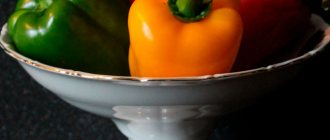Potatoes are rich in a huge amount of vitamins, minerals and nutrients that are so important for the well-being and proper development of a small child. But this vegetable is not recommended by pediatricians as early complementary feeding. Young parents should know when they can introduce potatoes into complementary foods for their child, and how to do it correctly. It is very important to follow the rules of complementary feeding, since the product should only bring benefits to the small organism. Otherwise, unpleasant consequences may occur.
Child eats mashed potatoes
The benefits of potatoes for baby nutrition
The benefits of vegetables for a small child are that they:
- Has a beneficial effect on the growth and strengthening of muscle fibers;
- Improves the psycho-emotional development of the child;
- Thanks to the large amount of fiber, it promotes proper digestion and cleanses the intestines of toxins;
- Reduces the amount of bad cholesterol in the liver and blood serum;
- Normalizes the functioning of the heart muscle and nervous system;
- Regulates metabolic processes in the body;
- Normalizes water-salt balance in the body;
- Restores acid-base balance;
- Helps cure various kidney disorders;
- Improves the functioning of all gastrointestinal organs;
- Promotes tissue healing in case of burns;
- Positively affects the functioning of the central nervous system and brain;
- Fills the growing body with the necessary energy.
Potato tubers
Composition and nutritional value
100 grams of boiled potatoes contain:
- 2 g proteins;
- 20 g carbohydrates;
- 0.2 g fat;
- 1.8 g fiber;
- 76 g water.
Potatoes are also rich in useful substances such as:
- Retinol;
- Ascorbic acid (vitamin C);
- Tocopherol (vitamin E);
- Thiamine (vitamin B1);
- Riboflavin (vitamin B2);
- Nicotinic acid (vitamin B3);
- Pantothenic acid (vitamin B5);
- Pyridoxine (vitamin B6);
- Folic acid (vitamin B9).
In addition, potatoes contain minerals such as:
- Potassium;
- Phosphorus;
- Chlorine;
- Sulfur;
- Magnesium;
- Calcium;
- Sodium;
- Zinc;
- Manganese;
- Copper;
- Iron;
- Boron;
- Molybdenum.
In what form can it be given?
First complementary foods while breastfeeding
In addition to the question of when it is possible to introduce potatoes into complementary foods, many parents are also concerned about another point: in what form is it best to give it to the baby. Until 9-10 months of a child’s life, potatoes can be given as complementary foods only in the form of puree, crushed to a uniform consistency, without any lumps.
At the eleventh month, you can offer the baby boiled potatoes, cut into small pieces, so that it will be convenient for the baby to pick it up with his fingers and put it in his mouth. Potatoes should be chosen that are crumbly and well-cooked, so that the baby can hold a piece in his mouth for a long time, and when he swallows it, he cannot choke.
You can also give your baby boiled, baked or steamed potatoes. All other cooking options are contraindicated for children up to two or three years of age.
Until the age of one, it is better to give potatoes as complementary foods in the form of liquid puree and soup. After a year, you can make cutlets from potatoes and steam them. In addition, it will be useful to add stew, borscht, and casserole to your baby’s diet. Baking is the best way to cook potatoes. During it, it reveals its natural taste and retains most of the nutrients.
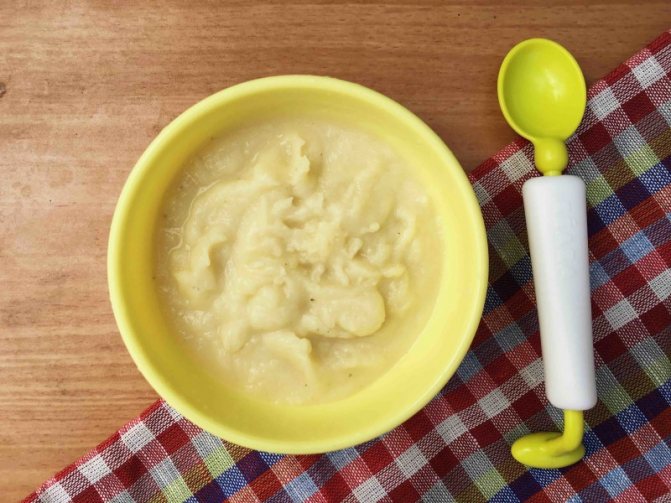
Puree for babies
Introduction to the diet
For the first time, a child should try mashed potatoes in an amount not exceeding a teaspoon. For a baby who reacted normally to such a vegetable dish, the portion will be increased next time. If the mother notes any negative or warning signs, introduction to potatoes should be postponed.
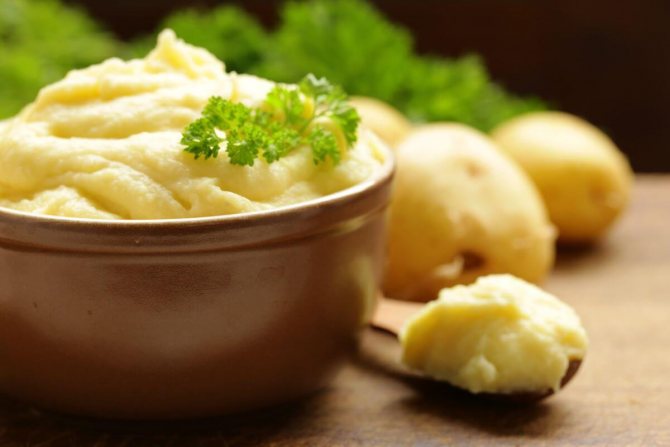
- The benefits and harms of mashed potatoes
- How to make mashed potatoes for your baby
- At what age can babies have mashed potatoes?
- Mashed potatoes for children: recipes
This root vegetable is recommended to be introduced into complementary feeding for infants along with vegetable and fermented milk products. Mashed potatoes for children are an almost perfect dish. It rarely causes allergies, does not lead to unpleasant surprises from the gastrointestinal tract of babies, has a neutral taste and delicate texture, and is very simple to prepare.
At what age can it be administered?
When to introduce potatoes into complementary foods? Vegetables can be introduced into a baby’s diet no earlier than he is 6-8 months old. If the newborn is bottle-fed, then complementary feeding begins at five months. Potatoes contain a lot of starch; in the first six months of life, a child’s digestive organs are not yet ready for such a “heavy” product. If potatoes are introduced into a newborn girl's complementary foods too early, it can cause gastrointestinal upset: colic may intensify, constipation and gas may appear.
Complementary feeding at 8 months while breastfeeding
The vegetable should not be introduced into the diet as an independent dish, but combined with other vegetable purees from various types of cabbage and zucchini. It is important to consider that the total volume of potatoes in vegetable puree should not be more than 50% of the entire serving of the dish.
Baby purees can be cooked either with water or with water and milk in a 1:1 ratio. If a baby who already has teeth is given potatoes not in the form of mashed potatoes, but in the form of tiny pieces, then chewing reflexes will begin to develop faster.
When it is possible to give potatoes to infants as complementary foods with the addition of boiled meat and other vegetables, many parents worry. Here you should wait until 1.5-2 years, then offer the baby more “complex” recipes. At this age, you can give your baby soup, stew, and casserole. Fried complementary foods are introduced into the baby’s diet only when he is 2.5-3 years old.
Additional Information. A well-known pediatrician, author of many books on the health and nutrition of children, Evgeny Komarovsky, when asked about the timing of introducing potatoes into complementary foods, answers that the optimal age is 8 months. In this case, the baby should already have grown several teeth. At first, the menu should include a decoction of potatoes, only then - mashed potatoes and soups with the addition of other vegetables.

Feeding a six month old baby mashed potatoes
How to choose a vegetable for complementary feeding
To prepare mashed potatoes, you need to choose intact, smooth tubers, small in size, without shoots and green spots in which the toxic substance solanine accumulates. They should also be fresh and firm. Droopy tubers are tasteless and contain few nutrients. The peel can be any color - pink, yellow, white.
It is best to prepare mashed potatoes for a child from potatoes grown in your own garden. If this is not possible, then it is advisable to purchase a local product.
Under no circumstances should you buy washed potatoes. It is quite difficult to wash off adhered dirt from tubers with water alone, so additionally use detergents similar to those used to wash dishes. In addition, to improve presentation and extend shelf life, manufacturers treat it with harmful compounds. Eating such potatoes, especially for children, is categorically not advisable.
How to cook properly
Feeding regimen for a breastfed newborn
Parents should put the most effort into preparing mashed potatoes when the baby first introduces them to potatoes. It is very important to understand what should be done so that the baby can appreciate both the taste and benefits of the vegetable without negative consequences.
How long to soak
Until approximately twelve months of age, the child should be fed only well-soaked potatoes. Vegetables should be soaked only in cold water. The first time soaking will take about 10-12 hours. To completely remove starch, you need to change the water at least two or three times. Then the time can be gradually reduced and by the year the potatoes are soaked for no more than 1-2 hours. After a year, you can cook potatoes for your baby, just like for all family members.
Potatoes must be soaked in water to remove all the starch, which is poorly absorbed by the small body. In addition, it increases insulin levels. Also, potatoes, as a tuberous vegetable, love to collect large amounts of nitrates and pesticides, so they should be soaked for at least several hours.
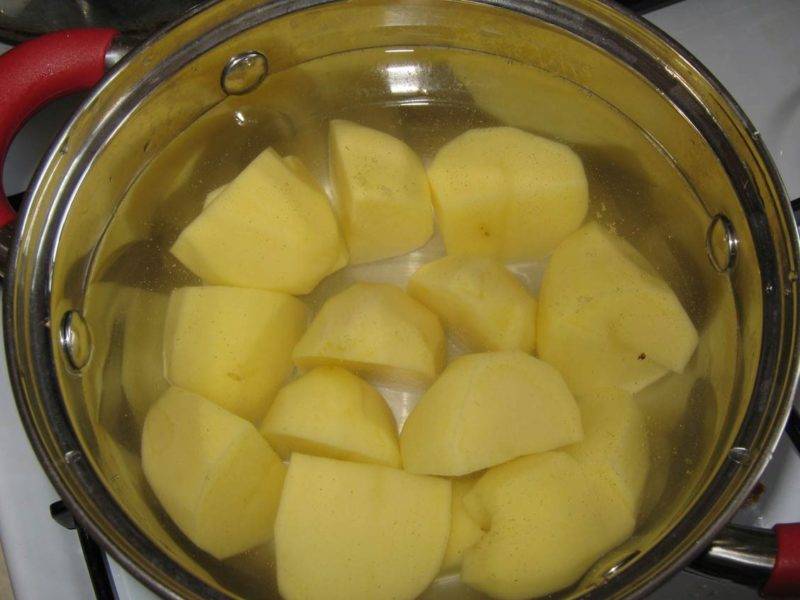
Soaking peeled potatoes
How to cook
For the first feeding, mashed potatoes for babies are best served as a one-ingredient dish. You can cook potatoes in any of three ways, whichever you like best: boil in the usual way, steam or bake. Potatoes baked in their skins will retain more nutrients, such as potassium, which is most found under the skins. Next, the potatoes should be peeled, crushed using a strainer or crushed with a masher. You can add breast milk or formula to the finished puree to give it a homogeneous, semi-liquid consistency, without lumps. There is no need to salt the finished dish.
Note! It is not advisable to use a blender during cooking, as the puree will become too sticky and difficult to digest.
At first, the potatoes should still be peeled. As soon as the baby has become familiar with the vegetable, it can be boiled or baked in the oven without peeling the skin; the taste of the product will be different, so it is important to introduce the child to all possible options for preparing the dish. After three years, you can treat your baby to potatoes baked over a fire, but you just need to thoroughly clean them of ash.
Recipes for babies from eight months
Mashed potatoes
Ingredients:
- 1-2 medium sized potatoes;
- 100 ml milk (breast and cow);
- 2 g butter.
Preparation:
- The potatoes are peeled, cut into pieces and boiled.
- Milk is boiled in a saucepan or ladle.
- First add butter to the pan with boiled potatoes, then milk to get the desired consistency.
- Blend the potatoes using an immersion blender.
Here is a simple recipe for mashed potatoes for babies that every mother can prepare.
Potato casserole
Ingredients:
- 200 g potatoes;
- 5 g butter;
- 50 ml milk;
- egg.
Preparation:
- Boil potatoes in their skins.
- Peel and grind with a blender.
- Add butter, egg and milk to the finished puree.
- Mix the mixture well and pour onto a greased baking sheet.
- Bake the dish at 200 degrees for about 30 minutes.
Potato casserole for a one-year-old child is a very healthy dish that the baby will like.
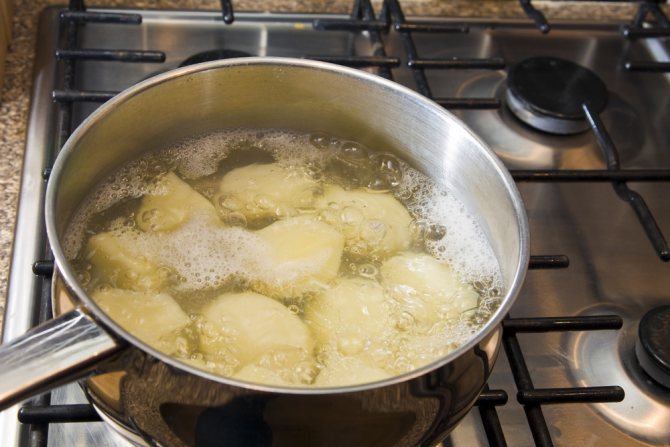
Potato boiling process
What can be combined with
After the baby is 8-9 months old, you can flavor the puree with 2-3 drops of vegetable oil to add flavor. When the baby is already 10 months old, you can add 1.5-2 g of butter to the puree.
After the child gets used to potatoes, you can add other vegetables to it, making the baby’s menu more interesting. From 7 months, potatoes can be mixed with broccoli or zucchini. From eight months - add beets and carrots. At nine months you can safely take cauliflower. At ten - prepare soup with vegetables and chicken fillet.
After a year, the child can be given potato pancakes, cutlets (baked in the oven, not fried in a frying pan), potato pancakes, baked potatoes, salads, casserole or stew with potatoes. From 1.5 years old, you can pamper your baby with chicken baked with potatoes in the oven (without adding oil).
What else do potatoes go with when breastfeeding:
- with different types of cabbage;
- with zucchini;
- with pumpkin.
A little later, it is recommended to add carrots and onions, season the puree with herbs, garlic, and supplement with meat, poultry, and fish. When introducing a chicken egg, a boiled yolk can also be added to the dish. But at the very beginning of introducing potatoes into complementary foods, this should not be done. Otherwise, if an allergic reaction occurs, it will not be easy to track what the reaction was to.

Potatoes can be combined with various vegetables
Dish recipes
Classic vegetable puree soup
You will need a small potato, carrot, cauliflower or broccoli (30 g). Wash the vegetables, peel and cut into small pieces. Then pour them with a small amount of water, put them on the stove and cook until tender. Mash the prepared vegetables thoroughly and dilute with the broth in which they were cooked to a liquid consistency. For taste, you can add 5 grams of butter.
Potato soup
Peel several medium-sized tubers, rinse well, cut into pieces and cook until tender. Then mash, add broth and half a glass of milk. Stir the mixture, place on the stove and bring to a boil. You can add 5 grams of butter and 2 tsp to the finished soup. carrot juice.
If your child’s complementary foods already contain meat, you can add it to the mashed potato soup, first finely grinding it in a blender.
You can start adding salt to children's dishes after a year and in a very small amount (at the tip of a knife).
Steamed potato cutlets in a slow cooker
The baby will eat these cutlets with great appetite. For them you will need two medium potatoes, a chicken egg, 400 grams of turkey or chicken fillet, 1 tbsp. flour.
Separately boil and chop the potatoes and meat. After that, they are mixed and the egg and flour are added. For taste, you can add a little salt to the dish and chop the herbs. Form small cutlets, place on the multicooker rack, and pour a liter of water into the bowl. Steaming is enough to cook the dish for 30-40 minutes.
It is not recommended to grind boiled potatoes in a blender. Otherwise, the puree will turn out viscous, like paste. The child may refuse such a dish. It is better to mash with a masher, fork or rub through a sieve.
Complementary feeding standards
Parents should adhere to certain standards for introducing potatoes into complementary foods.
How often to give
It is not advisable to give mashed potatoes to your baby every day. Due to the presence of starch, the dish will be difficult for the children's digestive system. It is enough to feed your baby this product 2-3 times a week.
It is better to feed your baby potatoes in the first half of the day, before 14:00. This will prevent possible consequences in the form of an allergic reaction or gas formation that may occur after eating such a heavy fruit as potatoes.
Quantity
It is recommended to start complementary feeding with 1 teaspoon and gradually increase it to a serving of 150 g. By the age of one year, the volume should be increased to 180-200 g per meal. At six months, a baby should eat 150 g of puree, at seven - 170 g, at 8-9 - 180 g, at 9-12 months - 200 g.
Important! When introducing complementary foods, it is very important to monitor the baby’s well-being, especially if he is bottle-fed. If excessive gas formation, colic, constipation, or diarrhea occur after eating potatoes, you should postpone your introduction to the vegetable for 2-3 weeks.

Complementary feeding starts with one teaspoon of mashed potatoes
Unexpected troubles
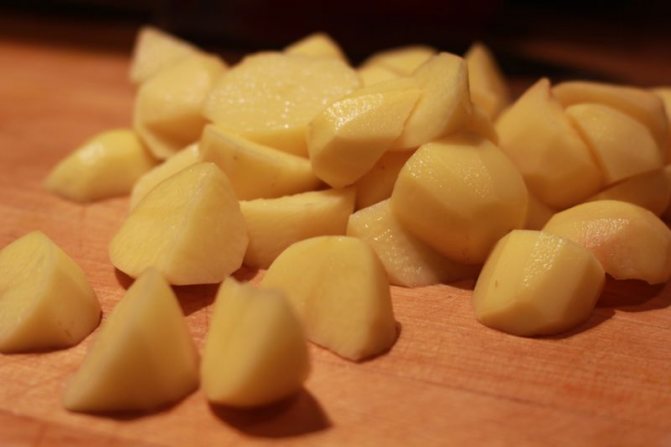
Despite all the beneficial qualities and properties of potatoes, some infants may develop a rash on their body after feeding them complementary foods - this is an allergy to starch. Then it is necessary to exclude the root vegetable from the little man’s diet until he is approximately 12 months old. Mom should not worry about this, since the baby can be fed with other hypoallergenic vegetables, from which he will receive nutrients and important vitamins in full.
In addition, excessive “love” for mashed potatoes in its pure form can lead to constipation in a baby, and an increased amount of carbohydrates can cause unhealthy weight gain in a toddler.
If mashed potatoes for babies are prepared correctly, and the baby is not allergic to the vegetable, then this root vegetable can become a source of valuable minerals, vitamins and other beneficial substances that are available all year round, which means that your treasure will grow and develop properly.
Pay attention to the video recipe for potatoes with green peas and veal for babies. Bon appetit!
Could it be an allergy?
An allergy to potatoes occurs very rarely in infants. If it appears, it usually occurs before the age of one year, during the period of introducing complementary foods. Children may be allergic to both raw and boiled potatoes.
How allergies can manifest themselves:
- Skin rashes, severe redness;
- Cough, difficulty breathing;
- Vomit;
- Decreased appetite;
- Swelling of the mucous membranes;
- Stomach ache;
- Constipation;
- Quincke's edema and anaphylactic shock.
Potatoes contain many chemical elements; most often, allergies are caused by protein and starch. If there can be an allergy to the first component, then to the second there is only increased sensitivity, since the product is poorly absorbed by the body, which leads to the appearance of unpleasant symptoms in the form of gas and constipation.
Important! If an allergy to boiled potatoes occurs in an infant, it is necessary to discontinue the product and contact a pediatrician who will prescribe enterosorbents and histamines. If a child is choking, blushes, or cannot take a breath, call an ambulance immediately, as the consequences may be irreversible.
Potatoes are an affordable, tasty, nutritious and nutrient-rich product, so they must be included in a baby’s diet. When administered correctly, it will help diversify the baby’s menu and will benefit his health, well-being and overall development.
How many months should a baby be for potato feeding?
A child should be fed mashed potatoes after he has normally accepted the introduction to other vegetable dishes of this nature. First, give your baby pureed zucchini, cauliflower, and possibly broccoli, and only then move on to potatoes.
Mashed potatoes can be given to a child of 5 months if he eats artificial mixtures. At the same time, it is still better to wait another three, four weeks - to be sure. If the baby is breastfed, then only from the sixth. Some doctors believe that this is best done from the eighth month.
The mother herself must decide what is best to do, since she knows her child well, how he tolerates foods and reacts to complementary feeding. After the first test, you can stop giving this product for a while, even if there are no visible problems, but the child feels heaviness or discomfort. It’s just that this feeding happened too early for him.
If there are no problems, then from the tenth month you can add finely chopped greens to mashed potatoes.








